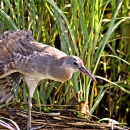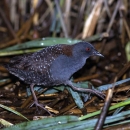Habitat restoration
Coastal Resilience Land Prioritization Effort
Partners: The Nature Conservancy Maryland/DC Chapter Resilient Coasts Program, U.S. Navy, U.S. Fish and Wildlife Service, Eastern Shore Land Conservancy, The Conservation Fund, and Ducks Unlimited
Location: Eastern Shore, Maryland
The need: Salt marshes on the Eastern Shore provide essential habitat to at-risk birds, such as saltmarsh and seaside sparrows, clapper rail, and eastern black rail.
- The Nature Conservancy’s (TNC) Resilient Coasts Program conducted a scientific and spatial analysis to identify resilient marsh complexes with the highest likelihood of persisting in the face of sea-level rise on Maryland’s Eastern Shore
- Based on the analysis, TNC has prioritized 20,000 ± acres of marsh habitat and migration zones for protection of critical marsh in Dorchester County
- In 2020, TNC partnered with the U.S. Navy to secure $3 million through the Department of Defense’s Readiness and Environmental Protection Integration (REPI) Challenge to permanently protect 4,000 ± acres in TNC’s priority area and the Navy’s Atlantic Test Ranges
- In February 2021, TNC partnered with the U.S. Fish and Wildlife Service, the Eastern Shore Land Conservancy, The Conservation Fund, and Ducks Unlimited to submit a North American Wetland Conservation Act (NAWCA) proposal to protect salt marsh salt marsh
Salt marshes are found in tidal areas near the coast, where freshwater mixes with saltwater.
Learn more about salt marsh habitats, migration zones, and adaptation areas in TNC’s priority area - TNC will be working with regional partners and landowners to develop conservation tools and techniques designed to enhance coastal resilience by enabling marsh migration and adaptation







